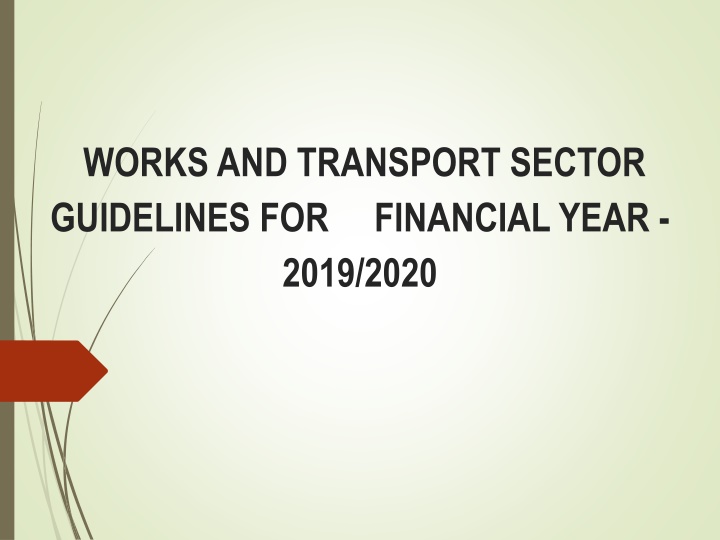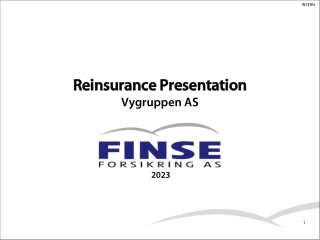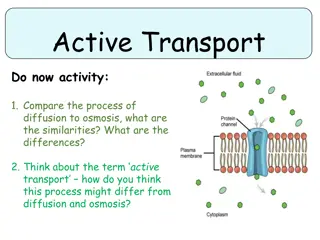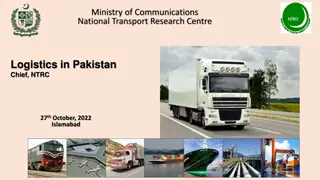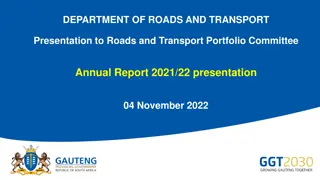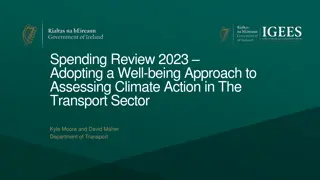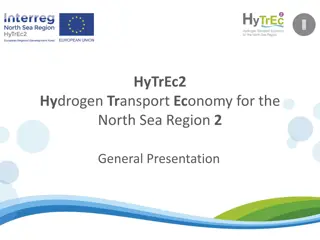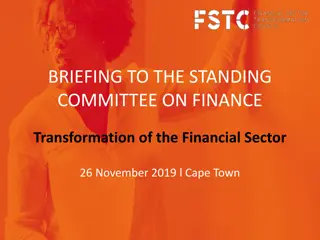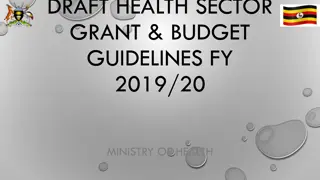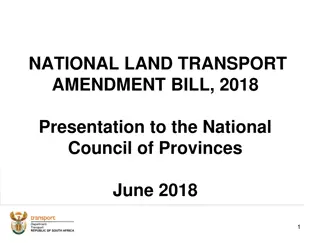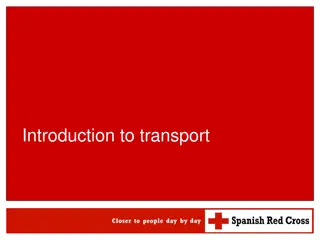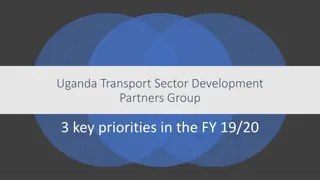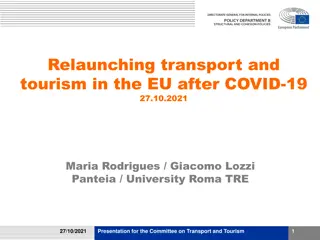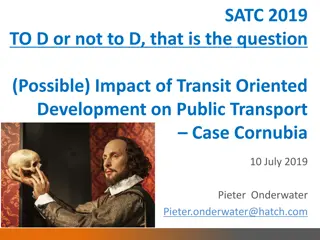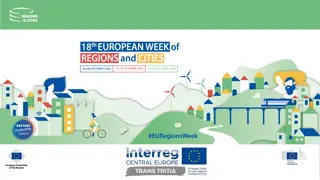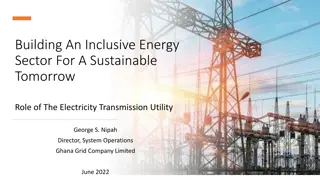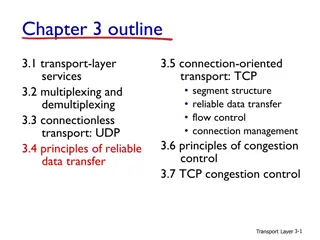Works and Transport Sector Guidelines for Financial Year 2019/2020
Roles, responsibilities, and mandates in the Works and Transport sector for the financial year 2019/2020 are outlined. Local Government responsibilities, MoWT guidelines, URF budgeting guidelines, and key issues are covered to ensure effective policy formulation, infrastructure development, and maintenance of roads in Uganda.
Download Presentation

Please find below an Image/Link to download the presentation.
The content on the website is provided AS IS for your information and personal use only. It may not be sold, licensed, or shared on other websites without obtaining consent from the author.If you encounter any issues during the download, it is possible that the publisher has removed the file from their server.
You are allowed to download the files provided on this website for personal or commercial use, subject to the condition that they are used lawfully. All files are the property of their respective owners.
The content on the website is provided AS IS for your information and personal use only. It may not be sold, licensed, or shared on other websites without obtaining consent from the author.
E N D
Presentation Transcript
WORKS AND TRANSPORT SECTOR GUIDELINES FOR FINANCIAL YEAR - 2019/2020
Presentation Outline 1.0 Roles, Responsibilities and Mandates 2.0 MoWT guidelines- FY 2019/20 3.0 URF budgeting guidelines- FY 2019/20 4.0 MoWT Programmes- FY 2019/20 5.0 Key issues 6.0 Conclusion
1.0 Roles, Responsibilities and Mandates 3 Local Governments: Local Government Act (Chapter 243) specifies responsibilities of LGs- (ss30,31), Under road services the construction, rehabilitation and maintenance of roads not under the Central Government. Roads that are the responsibility of Local Government are classified as District, Urban, or Community Access Roads (together referred to as DUCAR). Ministry of Works and Transport Policy formulation, standard setting, transport planning, monitoring and evaluation, and general oversight of the sector. legislation, strategic regulation, multi-modal District roads link communities to trading centres and national roads (responsibility of District Councils). Urban roads are in the boundaries of Municipalities and Town Councils (responsibility of Municipal and Town Councils). URF Finance maintenance of public roads in Uganda; Control of overloading of vehicles on public roads. the routine and periodic Community (responsibility of Sub-County). Access Roads are smaller link roads UNRA National roads (central government by Uganda National Road Authority (UNRA)). Plan, Develop and Maintain the national roads network; and axle load control.
2.0 MoW&T Guidelines RURAL TRANSPORT INFRASTRUCTURE (RTI) PROJECT FOR FY 2019/2020 2.0 Introduction: 25 Local Governments benefiting from the Rural Transport Infrastructure (RTI) Project. Of which 23 old and 2 new districts. 2.1 RTI targeted outputs: 500Km of district roads rehabilitated; 300Km of district roads sealed; 50 No. Small structures constructed/ rehabilitated; and 175 No. Community access interventions implemented.
2.0: MoW&T Guidelines Contd 2.2 FY 2019/20 RTI planned interventions All resources for FY2019/20 be directed towards sealing of district roads using Low Cost Sealing Technology; Quality checks on materials and works executed to be carried out; District not to approve and pay for works below the specified/acceptable quality; Quality test reports shall form part of the progress reports;
2.0: MoW&T Guidelines Cont 2.2 FY 2019/20 RTI planned interventions con td Ensure the road sections to be worked on are properly designed; To ensure quality works, all designs for low cost sealing shall be submitted to the Ministry for approval; Participating districts encouraged to use RAMPS as a planning and reporting tool.
2.3: (IPFS) for grant transfers to LGs -(RTI) Project for FY 2019-20 No. Vote Local Government IPF FY 2018/19 1 2 3 4 5 6 7 8 9 10 11 12 13 14 15 16 17 18 19 20 21 22 23 24 25 502 508 514 522 527 529 531 547 553 564 565 570 572 575 578 585 586 588 596 603 606 607 611 615 626 Apac District Gulu District Kaberamaido District Katakwi District Kitgum District Kumi District Lira District Pader District Soroti District Amolatar District Amuria District Amuru District Oyam District Dokolo District Bukedea Distrct Lamwo District Otuke District Alebtong District Serere District Ngora District Nwoya District Kole District Agago District Omoro Kwania Total 256,001,141 256,001,141 512,002,281 512,002,281 512,002,281 512,002,281 512,002,281 512,002,281 512,002,281 512,002,281 512,002,281 512,002,281 512,002,281 512,002,281 512,002,281 403,776,798 403,776,798 403,776,798 403,776,798 403,776,798 403,776,798 403,776,798 403,776,798 256,001,141 256,001,141 10,910,248,601
3.0: URF budgeting guidelines 3.0: Introduction: The URF allocation for FY 2019/20 has remained the same as for FY 2018/19 funding levels of UGX 542.52bn; Maintenance of public roads in FY 2019/20 shall continue to be financed from appropriations by Parliament via the consolidated fund; Allocations for the available funding has been based on the existing budget allocation formulae that gives effect to section 22 (2) of the URF Act, 2008; While the central allocation done by URF is to provide planning ceilings to various categories of DAs, the internal allocations to individual programs for road schemes are done by the agencies themselves; The allocation factors considered include the conditions of the public roads, maintenance requirements, and length of the road network and the relevant volume of traffic for each agency
3.1: FY 2019/20 global allocations per network category Road category FY 2019/20 budget (UGX) S/N Remarks Name Size (km) %age Amo unt (bn) % age of Total Change over FY 18/19 1.0 National 20,571 312.6 57.61 - For maintenance of national roads 15% 2.0 KCCA 2,103 30.56 5.63 - For maintenance of city roads 2% 3.0 District 34,381 74.94 13.81 - For maintenance of roads in 134 districts 25% 4.0 Municipa ls 3,198 34.79 6.41 - For maintenance of roads in 41 MCs 2% 5.0 Town councils 9,530 31.93 5.89 - For maintenance of roads in 214 districts 7% 6.0 CARs 68,933 17.71 3.26 - For maintenance of roads in 1,155 s/counties 50% 100% Total 138,716
3.2: Maintenance Policy for Agencies during FY 2019/2020 Maintenance plans and programs in the year shall be drawn and implemented within the following policy guidelines; Performance Agreementsshall remain the key Contract between URF and designated agencies and between Districts and their sub counties and Town Councils for purposes of delivering agreed annual work programs. Works on DUCAR network shall be implemented by Force Account (FA) while a mix of FA and contracting is allowed on national and city roads. Routine maintenance should be applied to maintainable road sections not undergoing periodic maintenance or other interventions;
3.2: Maintenance Policy for Agencies during FY 2019/2020 Periodic maintenance should be applied to roads and sections that maintenance not less than four years ago (gravel roads) or 7 years (paved roads) or for a paved road with roughness in excess of 3.5 IRI; First call on funds should be carried over projects from FY 2018-19; Road safety and Axle load control on the national network should be enforced; UNRA station Engineers should participate in the DRC meetings of administrative districts under their stations; last underwent periodic
3.2: Maintenance Policy for Agencies during FY 2019/2020 For city roads, priority should be given to routine maintenance and pothole elimination on key city routes; For city roads drainage maintenance and storm water management prioritized; Road formation camber and drainage should be enhanced and rendered operational to ensure a well-drained road network; should be
3.2: Maintenance Policy for Agencies during FY 2019/2020 For district roads, priority should be given to maintenance of roads connecting to UNRA roads; For urban roads priority should be given to maintenance of roads connecting to district roads; For community access roads, priority should be given to removal of bottlenecks; For CARs, as much work should be delivered through Bulungi bwansi.
3.3: FY 2019/2020 guidelines UGX 12.0bn for extended periodic maintenance of selected roads in Town Councils; UGX 1.783bn for repair and maintenance of small bridges and; UGX 3.566bn for emergency/special interventions. designated agencies to take into account conditions of the public roads, maintenance requirements, and length of the road network and the relevant volume of traffic when prioritizing funds; Quarterly disbursements will be in line with agreed annual programs and cash flow subjected to submission of timely accountability; Results shall be monitored and audited against key performance indicators (KPI).
3.3: FY 2019/20 guidelines contd Agencies to undertake road/structures inventory and condition surveys and provide data to URF as part of the Annual Road Maintenance Programme for FY 2019/20; DAs should submit their ideal maintenance requirements per intervention unconstrained budget scenario; DAs should complete preparation of their Annual Road Maintenance Programmes prioritized within the available budget and for the allowed works and submitted to the Fund by 31st Jan 2020. under the
3.3: FY 2019/20 guidelines contd All Annual Road Maintenance Programmes shall be accompanied by details of Force Account equipment and staffing returns in the Agency; Designated agencies should plan and budget for mechanical imprest (based on their needs) and training of operators and drivers up to a maximum 15% of their declared IPF; Accountability for mechanical imprest should be included within the quarterly physical and financial accountability productivity reports; and equipment
3.3: FY 2019/20 guidelines contd Designated agencies should allocate up to a maximum of 5% of their road maintenance budget towards road safety activities; All Annual Road Maintenance Programmes shall be accompanied by details of Force Account equipment and staffing returns in the Agency; DLGs and MCs operational expenses in FY 2019/20 capped at 4.5% of the budget; Cross cutting issues Due attention shall be accorded to the cross-cutting issues of environmental protection, HIV prevention and gender parity in road works. Evidence shall be provided in terms of budgetary provision and sustainable indicators.
3.3: FY 2019/20 guidelines contd Every Designated Agency will have to determine its maintainable network that shall be eligible for funding and declare it to URF. The declared network should not include roads that are receiving funding from other sources such as CAIIP, DLSP, PRDP, DANIDA, EU and USMID or under defects liability period.
3.3: FY 2019/20 guidelines contd Key disbursement triggers include: Signed Performance outlining key deliverable by the agencies in consideration of the sums to be disbursed; Satisfactory annual work plans with clear targets to be achieved and adequate elaboration of the methods to be applied; Satisfactory physical and financial accountability of previous funding; Satisfactory quarterly physical and financial accountability of previous funding; Evidence of receipt of funds of previous quarter; Evidence of timely transfers of funds to sub agencies; Agreements clearly
3.3: FY 2019/20 guidelines contd All designated agencies shall adhere to and observe the principles of quarterly reporting and accountability to URF on physical and financial progress as per timelines in the table below. S/N DESCRIPTION DEADLINE 1.0 Quarter 1 (one) accountabilities 15th day of October 2019 2.0 Quarter 2 (two) accountabilities 15th day of January 2020 3.0 Quarter 3 (three) accountabilities 15th day of April 2020 4.0 Quarter 4 (four) accountabilities 15th day of July 2020
3.3: FY 2019/20 guidelines contd All annual work plans prepared by agencies will have to be accompanied by a minute of the DRC approving the work plans before submission to URF; Districts and Municipals should make specific budgetary provisions to cater for the DRC operational costs separately from the 4.5% operational expenses budget line as guided by URF;
4.0: Planned programmes for 2019/20 by MoW&T Rehabilitation of 600km in various districts using Force Account; Interconnectivity program districts, especially Community Access Roads (800km); Rolling over of Low cost seal technology (25km); Rehabilitation and upgrading works in six urban councils. in various
5.0 HIGHLIGHTS ON THE KEY SECTOR ISSUES AND RECOMMENDATIONS FOR ACTION IN FY 2018/2019 23 Issue Recommendation and Progress A number of districts are misusing the new Japanese road construction maintenance equipment: There is need to continue sensitizing the districts on proper utilization of the equipment and for any faults to be promptly raised to the mechanical team for rectification. 1 and Untrained operators are being hired to operate equipment, abandoning the duly trained operators: The districts should utilize operators that have undergone the tailor-made training programs for the Japanese equipment. the new 2 In case of need to replace such operators, the new operators should be subjected to a proper orientation and hands-on supervision by the Chief Mechanical Engineer, MoWT or his authorized representative. training under
5.0 HIGHLIGHTS ON THE KEY SECTOR ISSUES AND RECOMMENDATIONS FOR ACTION IN FY 2018/2019 (CONT D) 24 Issue Recommend and Progress It s a challenge for attracting, recruiting and registered Engineers in LGs due to low salaries and experience required (9yrs) to be district engineer. The engineer s salaries were enhance and also the ministry is reviewing the requirements of 9ys as well as registration. 3 retaining Poor infrastructure programs by utility companies leading to damage of existing infrastructure like roads after construction coordination of The roads Bill, 2017 has provisions for construction of via ducts to cater for the utilities. 4 development
5.0 HIGHLIGHTS ON THE KEY SECTOR ISSUES AND RECOMMENDATIONS FOR ACTION IN FY 2018/2019 (CONT D) 25 Issue Recommend and Progress The Rehabilitation been allocated UGX 70 billion out of the required UGX 127 billion per year, i.e. UGX 1 billion to rehabilitate 50km per district: District Roads has There is need to continue lobbying for more funding to cater for the shortfall in order to clear the backlog. 5 5 Unit In the meantime, the workplan should be scrutinized with a view of prioritizing the works to cover the most critical ones first. High operators and road gangs due to poor pay staff turn over for The new rates for gangs where increased with the 6 gangs from UGX 100,000= to UGX 150,000. Head men from UGX 150,000 to UGX 200,000. The ministry is however, reviewing the pay for operators
6.0: Conclusion These Guidelines are intended to guide Agencies in planning for FY 2019/20 and they are complementary to the Process Guidelines and Manuals issued by URF as well as Force Account Guidelines of August 2017. DRCs for DUCAR Agencies are urged to oversee performance of the Agencies and to keep URF informed of the progress and any challenges met. Thank you for listening
